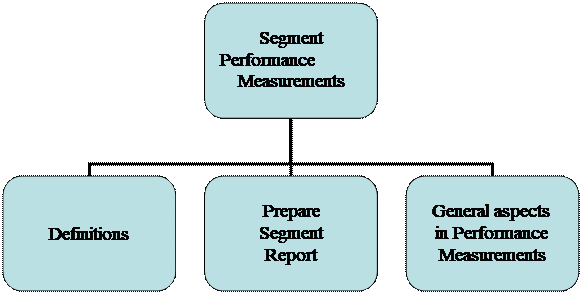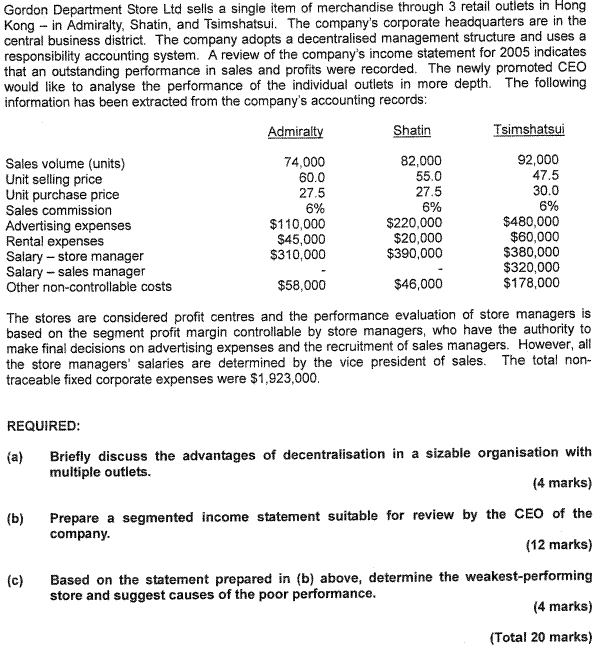Chapter 10 Segment Performance Measurements
LEARNING OBJECTIVES 1. Understand what a segment report is and its purpose. |


1. Allocation of Costs and Segment Report
(Jun 11, Dec 14)
1.1 |
Definitions |
|
(a) A segment can be an activity or a part of a company that involves revenue, costs and profit. For example, divisions of a company, individual stores, different geographical sales locations, different product lines, production plant, marketing departments and individual customers can give different segment. |
1.2 |
Example 1 |
||||||||||||||||||||||||||||||||||||||||||||||||
|
To illustrate how it works, here is an example:
|
1.3 In order to utilize segment reporting for achieving its purposes, costs must be properly allocated to segments properly. If the purpose is to determine the profits being generated by a particular division, all costs should be attributable to that division.
1.4 However, in daily operation, companies make mistakes easily when allocating costs to responsibility centres. Such problems generally include:
(a) Omit some costs through the value chain
(b) Allocate traceable fixed costs inappropriately as a result of failure to trace costs directly and with inappropriate allocation base
(c) Allocate common fixed costs arbitrarily (任意地) among segments.
1.5 All of the above problems may seriously affect the segments’ profitability and so may even result in dropping of some segments. The net effect would be reducing the overall profit of the company and make it even more difficult to cover those common costs.
2. General Aspects in Performance Measurements
2.1 In considering the segmental reporting, there are a large number of business performance measures which may be used.
2.2 |
Financial and non-financial measures |
|
(a) Financial performance measures include turnover, profit and return on capital employed. |
2.3 The areas of performance criteria will vary. Some of the criteria, and control and measurement used, are as follows:
Financial performance |
|
Competitiveness |
|
Activity |
|
Productivity |
|
Quality of service |
|
Customer satisfaction |
|
Quality of working life |
|
Innovation |
|
Examination Style Questions
Question 1

(HKIAAT PBE Paper II Management Accounting June 2006 Q6)
Question 2 – Segment reporting, responsibility accounting and decentalised structure
Agape Company manufactures and sells two types of mobile phone: 3G and 4G. The manufacturing information for the first quarter is as follows:
|
3G |
4G |
Sales in units |
5,000 |
3,000 |
Sales price per unit |
$3,000 |
$6,000 |
Variable production costs per unit |
$600 |
$1,200 |
Traceable fixed production costs |
$6,000,000 |
$9,000,000 |
Variable selling expenses per unit |
$300 |
$360 |
Traceable fixed selling expenses |
$300,000 |
$450,000 |
Allocated portion of corporate expenses |
$3,480,000 |
$3,600,000 |
Required:
(a) Prepare a segmented income statement for the first quarter, showing columns for the company as a whole and for each product. (8 marks)
(b) Explain why segment reporting is an extension of responsibility accounting. Use the data from part (a), point out the item(s) which is/are relevant for responsibility accounting. (3 marks)
(c) The director of the 3G product is responsible for its production and marketing. What are the advantages of such decentalised structure? (4 marks)
(d) What are the THREE levels of responsibility to which decentalised companies divide their segments? Describe briefly and indicate which level the 3G business belongs to. (5 marks)
(HKIAAT PBE Paper II Management Accounting and Finance June 2011 Q4)
Source: https://hkiaatevening.yolasite.com/resources/PBEP2Notes/Ch10-SegmentPerform.doc
Web site to visit: https://hkiaatevening.yolasite.com
Author of the text: indicated on the source document of the above text
If you are the author of the text above and you not agree to share your knowledge for teaching, research, scholarship (for fair use as indicated in the United States copyrigh low) please send us an e-mail and we will remove your text quickly. Fair use is a limitation and exception to the exclusive right granted by copyright law to the author of a creative work. In United States copyright law, fair use is a doctrine that permits limited use of copyrighted material without acquiring permission from the rights holders. Examples of fair use include commentary, search engines, criticism, news reporting, research, teaching, library archiving and scholarship. It provides for the legal, unlicensed citation or incorporation of copyrighted material in another author's work under a four-factor balancing test. (source: http://en.wikipedia.org/wiki/Fair_use)
The information of medicine and health contained in the site are of a general nature and purpose which is purely informative and for this reason may not replace in any case, the council of a doctor or a qualified entity legally to the profession.
The texts are the property of their respective authors and we thank them for giving us the opportunity to share for free to students, teachers and users of the Web their texts will used only for illustrative educational and scientific purposes only.
All the information in our site are given for nonprofit educational purposes